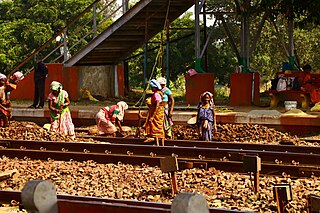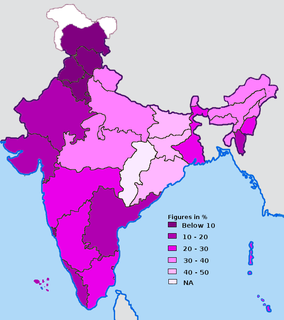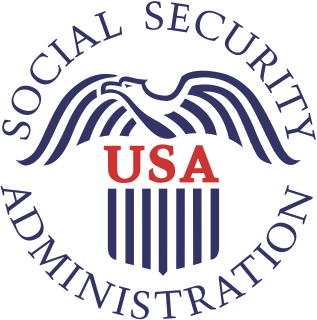Related Research Articles

Medicaid in the United States is a federal and state program that helps with healthcare costs for some people with limited income and resources. Medicaid also offers benefits not normally covered by Medicare, including nursing home care and personal care services. The main difference between the two programs is that Medicaid covers healthcare costs for people with low incomes while Medicare provides health coverage for the elderly. There are also dual health plans for people who have both Medicaid and Medicare. The Health Insurance Association of America describes Medicaid as "a government insurance program for persons of all ages whose income and resources are insufficient to pay for health care."

The poverty threshold, poverty limit, poverty line or breadline, is the minimum level of income deemed adequate in a particular country. Poverty line is usually calculated by finding the total cost of all the essential resources that an average human adult consumes in one year. The largest of these expenses is typically the rent required for accommodation, so historically, economists have paid particular attention to the real estate market and housing prices as a strong poverty line affect. Individual factors are often used to account for various circumstances, such as whether one is a parent, elderly, a child, married, etc. The poverty threshold may be adjusted annually. In practice, like the definition of poverty, the official or common understanding the poverty line is significantly higher in developed countries than in developing countries.

In the United States, the Supplemental Nutrition Assistance Program (SNAP), formerly yet still commonly known as the Food Stamp Program, is a federal program that provides food-purchasing assistance for low- and no-income people. It is a federal aid program, administered by the United States Department of Agriculture under the Food and Nutrition Service (FNS), though benefits are distributed by specific departments of U.S. states.

The working poor are working people whose incomes fall below a given poverty line due to low-income jobs and low familial household income. These are people who spend at least 27 weeks in a year working or looking for employment, but remain under the poverty threshold.
The basic needs approach is one of the major approaches to the measurement of absolute poverty in developing countries. It attempts to define the absolute minimum resources necessary for long-term physical well-being, usually in terms of consumption goods. The poverty line is then defined as the amount of income required to satisfy those needs. The 'basic needs' approach was introduced by the International Labour Organization's World Employment Conference in 1976. "Perhaps the high point of the WEP was the World Employment Conference of 1976, which proposed the satisfaction of basic human needs as the overriding objective of national and international development policy. The basic needs approach to development was endorsed by governments and workers’ and employers’ organizations from all over the world. It influenced the programmes and policies of major multilateral and bilateral development agencies, and was the precursor to the human development approach."
The Special Supplemental Nutrition Program for Women, Infants, and Children (WIC) is a federal assistance program of the Food and Nutrition Service (FNS) of the United States Department of Agriculture (USDA) for healthcare and nutrition of low-income pregnant women, breastfeeding women, and children under the age of five. Their mission is to be a partner with other services that are key to childhood and family well-being. The basic eligibility requirement is a family income below 185% of the federal poverty level. Most states allow automatic income eligibility, where a person or family participating in certain benefits programs, such as the Supplemental Nutrition Assistance Program, Medicaid, or Temporary Assistance for Needy Families, may automatically meet the income eligibility requirements. Currently, WIC serves 53 percent of all infants born in the United States.

Household income is an economic standard that can be applied to one household, or aggregated across a large group such as a county, city, or the whole country. It is commonly used by the United States government and private institutions to describe a household's economic status or to track economic trends in the US.

As India is one of the fastest-growing economies in the world, poverty is on the decline in the country, with close to 18 Indians escaping extreme poverty every minute, as per the World Poverty Clock. India had 53.5 million people living in extreme poverty which makes up 4% of its total population, according to the Brookings report. In May 2012, the World Bank reviewed and proposed revisions to their poverty calculation methodology and purchasing power parity basis for measuring poverty worldwide. It was a minimal 3.6% in terms of percentage. As of 2020, the incidence of multidimensional poverty has significantly reduced, declining from 54.7 percent in 2005 to 17 percent in 2020. Despite the pandemic its economy is healing

Poverty can be and is measured in different ways by governments, international organisations, policy makers and practitioners. Increasingly, poverty is understood as multidimensional, comprising social, natural and economic factors situated within wider socio-political processes. The capabilities approach also argues that capturing the perceptions of poor people is fundamental in understanding and measuring poverty.

In the United States, the lower class are those at or near the lower end of the socio-economic hierarchy. As with all social classes in the United States, the lower class is loosely defined and its boundaries and definitions subject to debate and ambiguous popular opinions. Sociologists such as W. Lloyd Warner, Dennis Gilbert and James Henslin divide the lower classes into two. The contemporary division used by Gilbert divides the lower class into the working poor and underclass. Service and low-rung manual laborers are commonly identified as being among the working poor. Those who do not participate in the labor force and rely on public assistance as their main source of income are commonly identified as members of the underclass. Overall the term describes those in easily filled employment positions with little prestige or economic compensation who often lack a high school education and are to some extent disenfranchised from mainstream society.
In the post-secondary education system of the United States, an expected family contribution (EFC) is an estimate of a student's, and for a dependent student, their parent(s)' or guardian(s)', ability to pay the costs of a year of post-secondary education. The EFC is used in the United States student financial aid process to determine an applicant's eligibility for need-based federal student aid. In most cases, the same estimate is also used for state and institutional (college-based) financial aid. The EFC is included on the Student Aid Report and Institutional Student Information Record, which are sent after filing a form called a Free Application for Federal Student Aid (FAFSA).

Income deficit is the difference between a single person or family's income and its poverty threshold or poverty line, when the former is exceeded by the latter. Data on the income deficits of various members of a population allow for the construction of one type of measurement of income inequality in that population. Individuals or families that fall below the line are considered to be in poverty whereas families that fall above are not. The income deficit is one of two measures that are used to determine a person or family's income distance from the poverty threshold, the other being a ratio rather than a difference.
Poverty in Canada refers to people that do not have "enough income to purchase a specific basket of goods and services in their community."
The ability of the United States government to tax and spend in specific regions has large implications to economic activity and performance. Taxes are indexed to wages and profits and therefore areas of high taxation are correlated with areas of higher per capita income and more economic activity.

Poverty in the United States of America refers to people who lack sufficient income or material possessions for their needs. Although the United States is a relatively wealthy country by international standards, poverty has consistently been present throughout the United States, along with efforts to alleviate it, from New Deal-era legislation during the Great Depression to the national War on Poverty in the 1960s to poverty alleviation efforts during the 2008 Great Recession.

Social programs in the United States are programs designed to ensure that the basic needs of the American population are met. Federal and state social programs include cash assistance, health insurance, food assistance, housing subsidies, energy and utilities subsidies, and education and childcare assistance. Similar benefits are sometimes provided by the private sector either through policy mandates or on a voluntary basis. Employer-sponsored health insurance is an example of this.
The term juvenilization of poverty is one used to describe the processes by which children are at a higher risk for being poor, suffer consistent and long-term negative effects due to deprivation, and are disproportionately affected by systemic issues that perpetuate poverty. The term connotes not just the mere existence of child poverty but the increase in both relative and absolute measures of poverty among children as compared to both other vulnerable groups and the population at large.
The California Work Opportunities and Responsibility to Kids (CalWORKs) program is the California welfare implementation of the federal welfare-to-work Temporary Assistance for Needy Families (TANF) program that provides cash aid and services to eligible needy California families.
Welfare in California consists of federal welfare programs—which are often at least partially administered by state and county agencies—and several independent programs, which are usually administered by the counties.
References
 This article incorporates public domain material from the Congressional Research Service document: Jasper Womach. "Report for Congress: Agriculture: A Glossary of Terms, Programs, and Laws, 2005 Edition" (PDF).
This article incorporates public domain material from the Congressional Research Service document: Jasper Womach. "Report for Congress: Agriculture: A Glossary of Terms, Programs, and Laws, 2005 Edition" (PDF).
| | This United States government–related article is a stub. You can help Wikipedia by expanding it. |